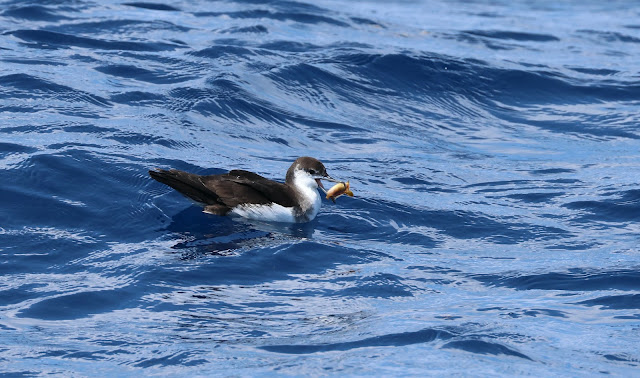Sorry for the radio silence folks, it's that time of year when the birds are flocking and the waves are pumping which makes it difficult to do anything but bird and surf. That's not even accounting for my son's Cross Country meets and other life stuff.
So now I have a huge backlog of photos including 2 days of pelagics out of Oregon Inlet. So without further ado.....
The pelagic on Saturday the 26Aug was kind of ho hum from a rarity standpoint but I always enjoy spending my time on the ocean.
Red-necked Phalaropes on the way out to the gulf stream.
Great Shearwaters are much more common in the late summer than other times of the year. They breed in the Tristan island group (Tristan da Cunha and Inaccessible Island) in the southern Atlantic which is basically halfway between Uruguay and South Africa. Talk about out there! How amazing are seabirds??!!
Audubon's Shearwaters are Sargassum specialists that feed on the critters that hang out and make their living in the floating weed. The above one was photographed on the 26th, but the below one was on the 27th.
Here you can see one that caught a nice sized Sargassum Fish or some other critter.
Cory's Shearwater - hopefully this species will be split in eBird someday soon to include the Scopoli's sub-species as a separate species. The Scopoli's sub-species breeds in the Mediterranean but then makes its living in the Atlantic. I am not sure if this is a Scopoli's, it is easier to ID then in flight.
Band-rumped Storm-petrel - we only had a few of these over the course of two days.
Band-rumped SP
Usually this time of year we get a ton of Black-capped Petrels, but I think they like a good wind and we had relatively light winds.
Even the Wilson's SPs were in low numbers both days.
Loggerhead Turtle! These are truly huge turtles!
Fairly early on the second day, we ran into a nice raft of shearwaters and other seabirds including....
South Polar Skuas
A Masked Booby!
Sooty Terns were abundant including these snazzy juvenile plumaged birds.
Scopoli's Shearwater - notice the white "finger tips" are extensive. The nominate sub-species has more dark feathering in the primary tips on the underside of the wing.
Here is one of the nominate sub-species typical of most Cory's Shearwaters. Note the dark primary tips.
One of the highlights of both days were the mammalian sightings. This Cuvier's Beaked Whale was a lifer for me, I think. I previously had seen Gervais' Beaked Whales. These are some cool cetaceans! They dive deeper than any other whales. They have been recorded diving up to 10,000 feet! That's insane.
I guess you need a huge blow-hole when you dive so deep. Not sure why the fins on the different whales I photographed look so different. I think maybe this is an older male that has seen some wear and tear on his dorsal fin.
This young Bridled Tern was a beauty with all the cool scalloping on the upper wing.
A Sooty Tern offering a nice view of the white outer retrices (tail feathers).
Audubon's Shearwater with Sargassum Fish.
Sooty Tern
Later in the day we found why the Black-capped were not obliging us with great views, they were just sitting on the water. Maybe they had a nice night of full moon fishing and were keen to just float in the low winds.
One of our last birds was this Trindade Petrel that flew in the distance and never really gave good looks.
Back home I tried birding a couple times, but it was still hot and slow.
Needham's Skimmer - when the birding is slow, go for the Odes (Dragonflies and Damselflies).
The weekend after the pelagic was also the weekend after Hurricane Idalia which left us relatively unscathed in Wilmington, but did end up giving us some storm birds. This storm came up from off the coast of the Yucatan where huge colonies of American Flamingos live. These colonies are known to get up and move to Cuba sometimes especially before or after storm events. The prevailing theory is that a bunch of flamingos were relocating from the Yucatan to Cuba when they got caught in Idalia's winds. Some folks have been able to read bands on the birds legs confirming they are from the Yucatan population.
Picture courtesy of ABA.org.
Flamingos were being found in Florida and as far afield as Ohio. So Jeff Lewis of Dare County was smart and went looking for them at Pea Island and I am glad he did. He found a flock of 11 at south pond on Pea Island. Off I went, knowing that some storm birds don't stick around long. I made the 5 hour drive only to find out the birds had flew! You can imagine my state of mind. However, I collaborated with a group of other birders to look further afield and before long got a notification that they had been found out in the sound a good ways out from the Split Pea bridge.
I got several different looks but they were far out and not conducive to photography.
Here are the 11 American Flamingos flying out over the sound near Split Pea.
Here is a picture I took in Cuba in 2017.
And one I took from the Yucatan in 2019.
Very cool. As I write this, they are still out in the sound near Split Pea but most folks are getting long scope views. It would be cool to bring a kayak out there and get some better looks without getting to close so as to not bother them.
I have one more post to write for some county birding I did last week, but I will save that for when I have some more material to add.


































No comments:
Post a Comment